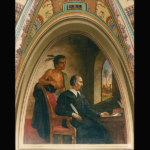Quote:
There were 60,000 people living on this island, including the Indians; so that from XXXX to XXXX, over 3,000,000 people had perished from war, slavery, and the mines. Who in future generations will believe this? I myself writing it as a knowledgeable eyewitness can hardly believe it.
Source:
Howard Zinn (1980): The People's History of The United States. New York: Harper Collins.
Author Bio:
Bartolomé de las Casas (1484-1566) was a member of the Dominican Order and active as a bishop in the Spanish colonies in America. The Valladolid dispute (1550-1551) between de las Casas and the philosopher Juan Ginés de Sepúlveda dealt with the question of the legitimacy of the enslavement of the indigenous population of America. Sepúlveda represented the interests of Spanish landowners, de las Casas pointed out the violent acts of the Spaniards. The missing dates are 1494 and 1508, a period of 14 years.
Context:
 In the first century of America's occupation, the population decreased by approximately 75 million (95% in some areas) as a consequence of imported disease and murder (Federici 2009: 85f.). As early as the 1560s, there were resistance movements against the Spaniards. For example, members of the Taki Onqoy movement (1560-1572), which arose in what is now Peru, were opposed to any cooperation with the Europeans and advocated an alliance of Andean indigenous peoples to end European colonisation. They rejected Christianity and Christian names as well as food or other consignments from the Spaniards, they paid no tribute and did not work for the conquerors (Stern 1982: 50ff.).
In the first century of America's occupation, the population decreased by approximately 75 million (95% in some areas) as a consequence of imported disease and murder (Federici 2009: 85f.). As early as the 1560s, there were resistance movements against the Spaniards. For example, members of the Taki Onqoy movement (1560-1572), which arose in what is now Peru, were opposed to any cooperation with the Europeans and advocated an alliance of Andean indigenous peoples to end European colonisation. They rejected Christianity and Christian names as well as food or other consignments from the Spaniards, they paid no tribute and did not work for the conquerors (Stern 1982: 50ff.).Further Reading:
*Steven J. Stern (1982): Peru‘s Indian Peoples and the Challenge of Spanish Conquest. Huamanga to 1640. Madison: University of Wisconsin Press, S. 50ff.
*Silvia Federici (2009): Caliban and the Witch. Women, the Body and Primitive Accumulation. New York: Autonomedia.
Year:
1508